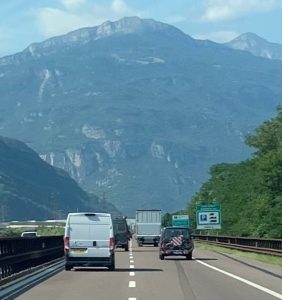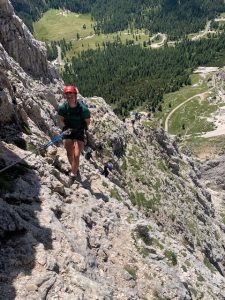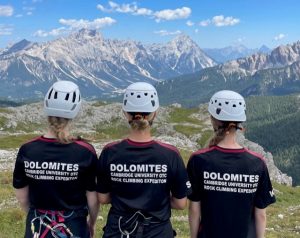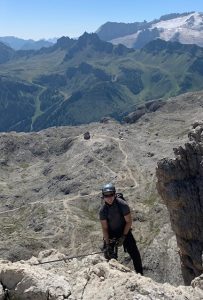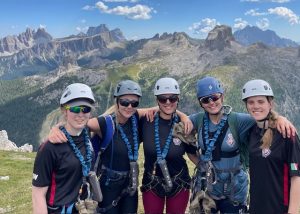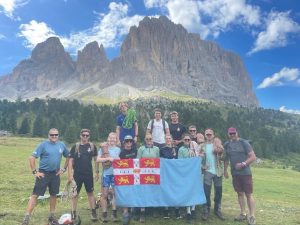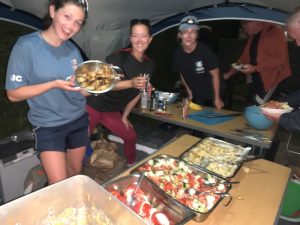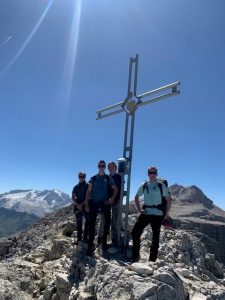At 3am on the 14th of August, 11 Officer Cadets & Staff from Cambridge UOTC left Cambridge Army Reserve Centre and headed for Ex DOLOMITES BLUE: a two-week rock climbing and via ferrata adventurous training expedition in the Italian Alps. We arrived at Dover in the early hours of Monday morning and landed in Calais at 6am. After a further 10-hour drive, we reached the Campsite Mer de Glace in Chamonix, a two-night stop allowing us to experience training in France and prepare for the Dolomites.
The Expedition
Theory Days
Day 1: Chamonix Valley
On our first day in Chamonix, it was peak holiday season, and after struggling find rockface availability to opted to spend the time reviewing the basics of Rock Climbing and Via Ferrata. Starting with rope work and correct belay set up, an essential for the coming days, the OCdts moved on to learning about prusik types and the pros and cons of the French, standard and klemhiest prusiks. This set us up well for our introductory climbs the next day.
Day 4: Corvara
Whilst one half of the group undertook a via ferrate route, 7 other cadets hiked up the pastes in Corvara before finding a spot to practice traditional climbing techniques. For several of us, this was completely new information, and we were introduced to the importance of the placement of Protection including Nuts, Hexes and Cams, as well as how to make safe at the top of each climb – or pitch. As well as this, it was emphasized how important it was to combine the use of correct rope vectors with minimalist equipment usage to ensure the system was not overloaded but that all kit was backed up to reach the ten-point safety scheme.
Day 7: The Lagazuoi tunnels, Passo Falzarego, descent of 700m
During the conflict between the Italian and Austria-Hungarian troops in WW2, a group of Italian engineers attempted to undermine the Austrian emplacements by digging a system of tunnels that lead from the Martini Ledge up to the fore-summit “Anticima” of Mt. Lagazuoi.
On our 4th day, we explored the via ferrata style route which travels down the tunnels totalling 700m of horizontal descent. As well as exploring the tunnel system which was designed for troop movement, we also saw the officer’s quarters and the machine gun posts. Knowing that soldiers would live in these cave systems for months at a time was astounding, especially given the damp nature and frequency of rockfall.
Practical climbing days
Day 2: The City of Stones
Our first day of climbing began with the treacherous drive up the winding mountain roads to Citta dei Sassi, which translates literally to the “City of Stones”. This is one of the largest climbing areas in the Dolomites and was perfect to allow our OCdts of varying abilities to all have a fulfilling reintroduction with rock climbing. The cliff itself if divided into 15 sectors, with over 140 climb routes ranging from grade 3 to 8a. We worked across four introductory climbs in section 4, with some of our cadets belaying for the first time. As the rain came in,
Day 3: Marmot Rock
During a week of climbing in the stunning Dolomiti mountain range, our limits were put to the test as we ventured beyond our comfort zones. The third day once again brought us face to face with the Marmot Rock, where we tackled the demanding routes of Poppi (6b), Edith (6a), and Natalie (6a). These climbs, with their formidable difficulty, forced us to slow down, encouraging us to meticulously consider our technique and hand placements. JUO Whyte’s relentless determination, spending over an hour on a single climb, epitomized the unwavering spirit of our group.
The triumphs achieved on these challenging ascents were particularly rewarding, serving as a testament to our hard work throughout the day. With the Dolomites as our backdrop, the sense of accomplishment was truly profound.
Day 5: Michl-Martl Stoan, Sella pass
After a day of rest and technique reviewal, we returned to Marmot Rock and set up climbs on the alternate routes to day 3. Whereas on day 3, our more novice climbers all struggled to top out on any of the climbs, all of our climbers were able to complete at least one of the 6c routes, having massively improved both in technique and confidence from two days prior. This day demonstrated to us the importance of perseverance and self-belief in rock climbing, skills we can of course transfer into other challenges, both military and otherwise.
Via Ferratta:
Via Ferrata translates to “iron way” in Italian and originates from WW1. With a large number of troops focussed on the threat of Russia, the Austro-Hungarian defensive line was retracted and reformed running through the Dolomites, meaning that battles were brought into the hostile conditions of the mountain region. To aid in the movement of troops, permanent metal wires, ladders and metal struts were fixed to the cliffs, allowing soldiers to move up sheer rock faces with relative safety and speed. Via ferrata paths then began to be used to transport troops to otherwise inaccessible locations within the mountains, allowing them to carry heavy kit whist attached to the very mountains they were scaling.
Knowing that the same activity we were participating had been a necessity for military personnel in the past, and imagining what it could have been like to not only be outside of your comfort zone hanging from a sheer rockface but to be doing so under threat of gunfire whilst carrying heavy kit, made the experience even more awe-inspiring. Nowadays, via ferrata includes clipping yourself into steel cables and climbing up steel ladders integrated into the rockface, as well as side stepping across rockfaces and crossing rope bridges. It forces you to have complete faith in both your equipment and you; at the end of the day, that’s all that’s keeping you safe 2000-3000m up.
Although the majority of OCdts had been introduced to via ferrata during the multi-sport AT package in Chamonix, one OCdt James Preece, describes how he found this novel experience:
“Before going on this trip, I had heard fantastic things from friends about via ferrata but had not tried it myself and was therefore filled with the trepidation and excitement naturally resulting from stories of dangling off rock faces held by a cable. This trepidation quickly disappeared and was replaced by a determined purpose to scale the huge rock face stretching into the sky which I found myself before, and subsequently by an elated euphoria upon reaching the top and taking in the views.
OCdt James Preece
The constant problem solving when on the rock face in regard to where to best place hands and feet, combined with overcoming the concomitant physical and psychological challenge of being attached to a cliff at 2000 metres above sea level, was immensely rewarding. Not only was it a completely novel experience, but the exciting ability to scale vast cliffs quickly, with friends who are enjoying the breath-taking panoramic views of the Dolomites and Alps nearly as much as you, made for a terrific time that I will remember forever. I had a brilliant time thanks to the difficulty of the activity itself, the picturesque location, and the value of via ferrata being so accessible; to summit vast rock faces without complex multi pitch climbing is a wonderful thing, and I personally cannot wait to do it again at the next opportunity!”
Day 6: Via Ferrata at Delgi Alpini, range in difficulty from grade A to D with D being the starting section, very climb heavy with little metal placement for support. Ascent from 2188m to 2515m.
Another nerve-racking segment of the week was the initial ascent of the “Via Ferratta degli Alpini,” which was graded as a D. This experience heightened our appreciation for the intricacies of via ferrata climbing, from strategically deciding when to clip in and out of safety gear to seeking respite in less taxing positions. We also learned the importance of efficiently managing our via ferrata equipment while navigating the route.
Day 8 – Chamonix Valley
On the final active day of our expedition, we were once again in Chamonix valley, and decided to utilise our increased via ferrata competency to explore the rockfaces further. The group split with half heading to the Via des Evettes, a traditional via ferrata style route including two tension rope bridges and several complex overhangs.
The other half of the group completed route 1 at Le Mont, Sixt-fer-a-Cheval. This was a 3-hour route covering 800m of grades ranging A to D. Furthermore, this route included large sections of descent, which were surprisingly even more challenging than the ascent especially considering the height of the Officer Cadets climbing (all girls below 5”6).
This day imposed upon the cadets the importance of weather consideration during route selection. With temperatures of 33 degrees C, the exposed rock faces were reflecting both sunlight and heat, meaning we fatigued far faster than usual. The shorter routes had been chosen because of this, and those at Le Mont were lucky enough to take an alpine lake dip to cool off once they had completed their challenging climb!
Officer Cadet Development
Driving:
Our journey to the Dolomites was an unexpected adventure, filled with the unique experience of driving the combi vans in Italy for 2Lt Knight, 2Lt Friend, SUO Prockter, and JUO Cunliffe. It marked the first time we had ever driven in a foreign country, and it was a privilege to take on the responsibility of navigating the winding roads of Italy while transporting staff and enthusiastic cadets.
This experience made us feel like integral members of the G4 team, contributing significantly to the trip. We shared the long and scenic journey through France, and with our fellow Officer Cadets strapped in behind, we embraced the challenges of the road.
The time spent behind the wheel during this expedition has honed our driving skills and demonstrated our competence. This newfound confidence opens doors to lead and participate in future expeditions, granting us the freedom to tailor our adventure training within the Cambridge University Officer Training Corps.
We owe a debt of gratitude to the Ulysses Trust for their generous funding, without which such enriching experiences would not be possible. Each adventurous training opportunity builds upon our skill set, allowing us to craft our own unique path within the Corps. The Dolomites trip was just the beginning of our exciting journey towards AT leadership excellence.
Cooking
Ex DOLOMITES BLUE exposed us not only to the adventurous activities themselves, but also to the planning that AT expeditions require. The expedition used self-catered campsites in the Chamonix valley and in the Dolomites, meaning that each day two pairs of cadets were chosen to cook for our camps. We had to plan a meal within our given budgets, buy the ingredients ourselves and then cook on gas barbeques once we had returned from a hard day’s training. Not only did this help develop an understanding of planning, delegation, time-management and teamwork, but this also created a healthy competition between the OCdts for who could create the best dinner.
The Impact of the Trip:
All Officer Cadets were exposed to a new form of risk. Whether height, speed, exposure, trusting their equipment and their team or overcoming a personal fear, each OCdt waschallenged to reflect on their own perception of their mental boundaries, and then re-establish them after they had undertaken a challenging activity. Although via ferrata may seem the most mentally challenging activity due to the exposure, height and novelty, those OCdt who were less experienced in climbing faced the mental pressures of overcoming physical struggle with problem solving as well as trusting in their partner OCdt belaying them below. The trip has built close relationships of trust that will continue to strengthen in future adventure training and military exercises.
Cadet feedback
“The challenges encountered during the week ignited a newfound passion for both traditional climbing and via ferrata. The expert guidance from our instructors during the trip greatly contributed to our growth as climbers, leaving us more skilled and confident. As members of the Cambridge University Officer Training Corps, we now stand ready to take on future climbing expeditions with newfound expertise and enthusiasm.”
Jess Cunliffe, JUO
“This was probably the best exped I have attended in CUOTC so far. It was very well put together and everyone, including the staff, did amazingly.”
Anon, Officer Cadet

